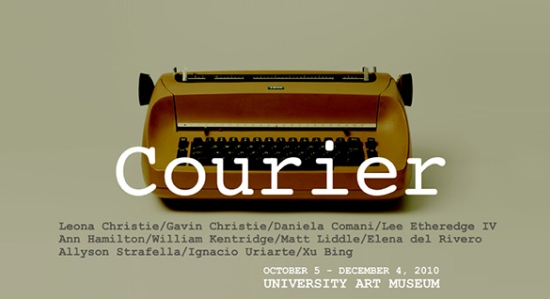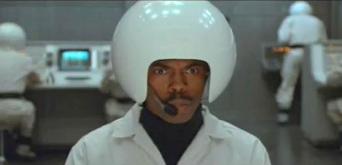University Art Museum Takes On the Typewriter with 'Courier'

The fall season gets underway at the University Art Museum on Oct. 5 with the opening of 'Courier.'
ALBANY, N.Y. (September 26, 2010) --
The University Art Museum will present 'Courier,' a group exhibition featuring eleven contemporary artists who have created works that are rooted in the physical, communicative, or iconic properties of the typewriter. The exhibition opens on October 5 and runs through December 4, 2010.
From emblematic homage to pointed social critique, the works selected for this exhibition demonstrate that despite its obsolete status, the typewriter remains a potent carrier of untapped ideas.
Leona Christie/Gavin Christie, Daniela Comani, Lee Etheredge IV, Ann Hamilton, William Kentridge, Matt Liddle, Elena del Rivero, Allyson Strafella, Ignacio Uriarte, and Xu Bing expand on the typewriter’s expressive potential in work that employs a range of mediums including film, printmaking, photography, installation, and the typewriter itself.
Several artists in Courier present work that references the typewriter as a touchstone to history:
- Zeno Writing (2002), an 11-minute animated film by South African artist William Kentridge, combines drawing and photomontage with period footage in a graphic re-telling of Italo Svevo's 1923 novel Confessions of Zeno. Punctuated by the repetitive sounds of a typewriter's carriage return, the film's sound track underscores the anxiety of the novel's guilt-ridden protagonist as he attempts to navigate the broader social upheavals of industrial development and the threat of war.
 |
The History of the Typewriter, a film by Spanish artist Ignacio Uriarte documents Michael Winslow, right (from Spaceballs), as he recreates the distinct mechanical sounds of iconic typewriters from the 1870s to the 1980s. |
- The History of the Typewriter (2009), a film by Spanish artist Ignacio Uriarte documents actor/comedian Michael Winslow (famous for his gifted ability to simulate sound effects using his voice) as he recreates the distinct mechanical sounds of iconic typewriters from the 1870s to the 1980s.
- Berlin-based artist Daniela Comani's It was me/Diary 1900-1999 (2008) conflates the history of the twentieth-century into an outsized diary that spans 18-feet and includes 365 typed journal entries that place her at the center of important historical events.
- Lee Etheredge IV's most recent typewriter drawings combine contemporary photographs of Civil War battlegrounds with typed lyrics from Civil War songs. The subtle patterns created by the repeated typing of a single refrain cascade over the images of now-placid landscapes, providing an air of metaphorical healing that belies the enormity of what took place long ago.
- Similarly, the physical act of typing serves to embed memory and chart the passage of time in Nine Broken Letters (2002-04), an installation of ghost-like, barely decipherable drawings by Spanish-born artist Elena del Rivero. Based on her fragmented writings composed in the wake of 9/11, Del Rivero uses both the typewriter and hand-calligraphy to give visual form to her ruptured thoughts while simultaneously acknowledging that it is impossible to rely on language alone as a means of communication.
- Dark woods, light woods (2010) a print project by Leona Christie in collaboration with her autistic savant brother Gavin Christie also begins with the impulse to merge memory with the physical act of typing. Leona Christie has transformed Gavin’s detailed typed lists of Detroit's suburban roadways, which he records from memory at the end of his daily travels, into a series of embossed prints that evoke the engraved text of memorials as well as modernist poetry.
- Although the typewriter is not directly involved in Ann Hamilton's a,b,c (1994-99), a 26-minute video loop, she addresses the relationship between the written language and tactile experience through the deceptively simple action of watching a wetted fingerprint slowly erase inked letters of the alphabet on a pane of glass and then retrace its path, "writing" the letters in reverse. In this instance, the intimacy of touching each letter of the alphabet suggests a metaphorical gesture akin to the physical act of typing.
For other artists in the exhibition, the typewriter keyboard yields ample possibilities as a mark-making tool:
- In a new series of prints and drawings, book artist Matt Liddle considers the unique properties of the landmark IBM Selectric typewriter -- especially its pivoting "typeball" with changeable fonts. The patterns that emerge from his labor-intensive exercises form unexpected margins and gutters that reference the book page, but are not meant to be "read" in a traditional sense.
- Allyson Strafella equates the manner in which she navigates space, form and placement in her typewriter drawings with that of driving a tractor across farm fields (which she did for a brief time in 2003). The images that emerge from her free-form typing suggest fragments of tilled terrain seen from above. Recently, she has been making larger drawings on a reconfigured typewriter outfitted with an extended carriage and keys based on her own invented alphabet.
- Xu Bing's interactive project Book from the Ground (2003-present) relies, not on typewriters, but computers. What links his project to other works in the exhibition is the physical action of typing itself. Based on the artist's extensive collection of airline safety manuals, Xu Bing has created a computer program that allows participants to communicate with one another in real time and across cultural boundaries by typing in a language of universal understood icons.
- Courier is curated by Corinna Ripps Schaming, Associate Director/Curator, University Art Museum and will be documented in a fully-illustrated catalogue featuring essays by Barry Sanders, cultural historian and James Siena, artist and avid typewriter collector.
Exhibitions, publications, and public programs are made possible with support from the UAlbany Office of the President, the Office of the Provost, University Auxiliary Services, Marjorie L. Brandon, the Ellsworth Kelly Foundation, The Andy Warhol Foundation for the Visual Arts, and the Center for Jewish Studies at UAlbany.
Annie Cohen-Solal's lecture is co-sponsored by the New York State Writers Institute, UAlbany Art Department, and the Department of Languages, Literatures, and Cultures.
![]() For more news, subscribe to UAlbany's RSS headline feeds
For more news, subscribe to UAlbany's RSS headline feeds
Educationally and culturally, the University at Albany-SUNY puts "The World Within Reach" for its 18,000 students. An internationally recognized research university with 58 undergraduate majors and 128 graduate degree programs, UAlbany is a leader among all New York State colleges and universities in such diverse fields as public policy, nanotechnology and criminal justice. With a curriculum enhanced by 300 study-abroad opportunities, UAlbany launches great careers. For more information about this globally ranked University, visit https://www.albany.edu/. For UAlbany's extensive roster of faculty experts, visit www.albany.edu/news/experts.shtml.


